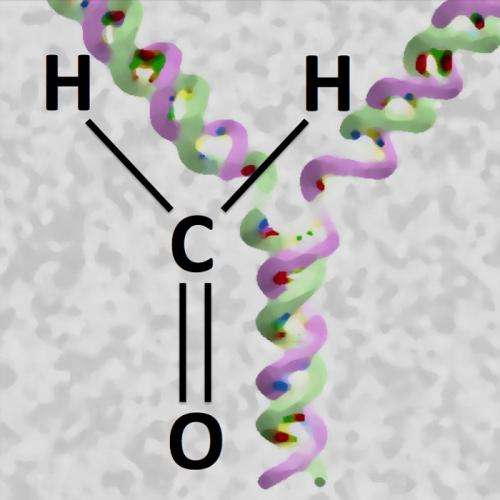Formaldehyde, generated in cells or derived from the environment, can crosslink DNA to proteins, which interferes with DNA replication. The newly identified repair protein Wss1 chops down the protein component of DNA-protein crosslinks, thereby enabling cells to complete replication. Credit: MPI of Biochemistry/ S. Jentsch
DNA—the carrier of genetic information—is constantly threatened by damage originating from exogenous and endogenous sources. Very special DNA lesions are DNA-protein crosslinks - proteins covalently linked to DNA. So far hardly anything was known about repair mechanisms specifically targeting DNA-protein crosslinks. Stefan Jentsch's team at the Max Planck Institute of Biochemistry in Martinsried, Germany, now discovered a protease that is able to chop down the protein component of DNA-protein crosslinks, thereby enabling organisms to copy their genetic information even if crosslinks arise. The results of this study have major implications for the understanding of genome integrity and cancer development.
The DNA in each cell is highly vulnerable to various types of damage. A special class of damage is caused by reactive compounds, such as formaldehyde, which are produced as byproducts of cellular reactions and cause the crosslinking (a formation of a covalent linkage) of proteins to DNA. Importantly, these so-called DNA-protein crosslinks are also caused by several anti-cancer drugs and are extremely toxic as they interfere with essential processes such as DNA replication. Cells need to unwind and separate the DNA double helix in order to copy its genetic information prior to the next round of cell division. DPCs inhibit this process by blocking the way of the unwinding enzyme replicative helicase, thus preventing replication and consequently cell division.
In the laboratory of Stefan Jentsch at the Max-Planck-Institute of Biochemistry, scientists now identified the protease Wss1 as a new safeguarding factor that chops down the protein components of DNA-protein crosslinks and thereby enables cells to duplicate their genome. Julian Stingele, a PhD student in the laboratory, found that cells lacking Wss1 are particularly sensitive to formaldehyde, extremely vulnerable to DNA-protein crosslinks and suffer from genomic instability. Notably, Wss1 has the unique property to cleave proteins only in the presence of DNA, suggesting that the enzyme is well tailored for its task to remove crosslinks from the genome and thus preserve genome stability.
Because the repair of DNA lesions is essential to prevent cancer formation, it is of crucial importance to understand the underlying cellular mechanisms. The newly identified DNA-protein crosslink-repair pathway is particularly important for rapidly dividing cells. Given the fact that cancer cells divide much faster than the majority of human cells, Wss1 might be an attractive future drug target for cancer therapy.
More information: J. Stingele, M. Schwarz, N. Bloemeke, P. Wolf, and S. Jentsch, A DNA-dependent protease involved in DNA-protein crosslink repair. Cell, July 3, 2014
Journal information: Cell
Provided by Max Planck Society






















